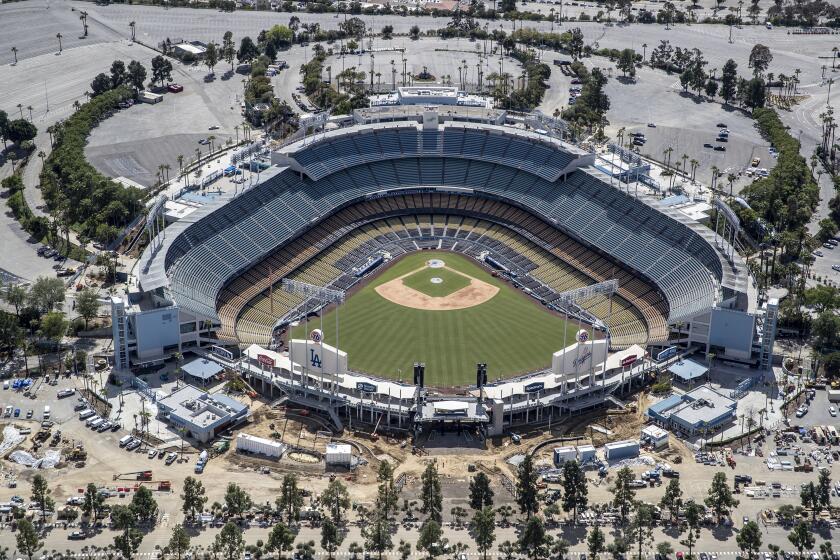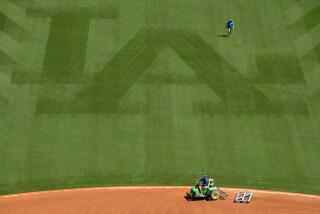MLB on TV: Nine ways baseball can enhance how fans watch games in 2020
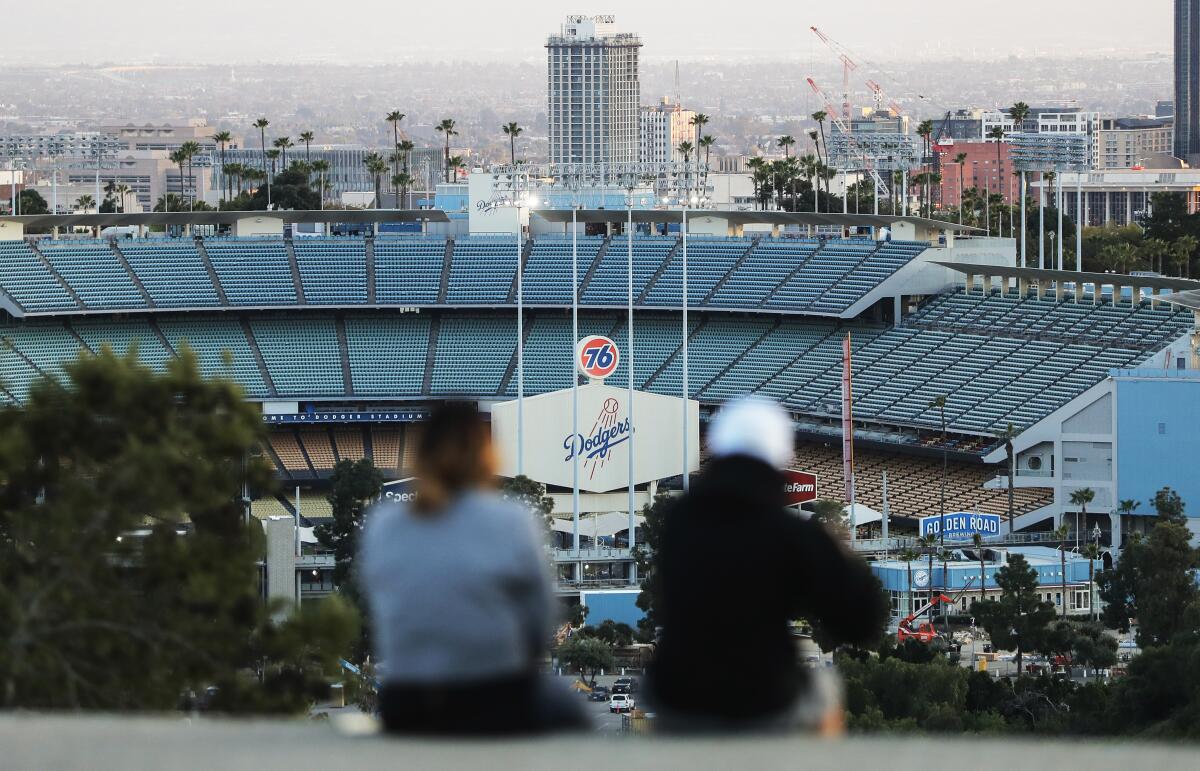
- Share via
Baseball is less than three weeks away from beginning a 60-game regular season. Fans won’t be allowed to attend games, at least at the outset, making television and perhaps online streaming the only ways to watch. Teams and networks have an opportunity to enhance the viewing experience in ways never done before.
Here are nine ideas:
Hear, hear
Baseball is the only sport where spectators can close their eyes and know exactly where they are. Baseball is a sport of sounds — the crack of the bat, the thump of a glove, scream of an umpire, the rolling resonance of an organ. In order to connect with fans who in 2020 can only watch on TV, baseball needs to transform this remote season into one of simple, joyous noise.
Put a microphone on every ballpark sound. Let us hear the organist’s pregame melody, the crooning national anthem singer, the players’ walk-up music, even the between-innings techno pop. Put a microphone on every base, tuck one into every glove, let us listen to the eternal summer soundtrack. This would not require pestering players to do in-game interviews or begging a reluctant pitching coach to wear a mic during mound visits. This is about letting the game speak for itself.
Let us feel the two thumps of a double play grounder. Let us marvel at the thwack of a fastball strike. Let us cringe at a screaming called third strike. Let us be startled by the crack of a bat that is so loud, we know it’s a home run before it clears the fence. And after Dodgers victories, let us stand up and dance to “I Love L.A.”
Let us hear the game as if we were actually at the game. In a summer and a season desperate for normalcy, it would be music to our ears.
— Bill Plaschke
Drive in, tune in

How about a good, old-fashioned drive-in? Transforming a parking lot into an outdoor cinema would be easy enough. The endeavor would require a projector, a screen and security officers in charge of enforcing local health and safety regulations.
Fans would park, turn off their engines and listen on the radio as the action unfolds on a canvas in front of them. They can even celebrate with a neighboring carload of fans — at an appropriate distance, of course.
If hosting an outdoor gathering isn’t possible, teams could host virtual viewing parties. They can broadcast games on their Facebook or YouTube pages; those platforms allow fans to interact with each other in written comments.
By providing the public a unique way to simulate the experience of being in a stadium with other people, maybe teams can regain the trust of the fans disenchanted by the ugly, money-driven battle between players and owners about the league’s return to play.
— Maria Torres
Real deal cheers and boos
MLB’s Operations Manual is filled with rules and protocols that will make the 2020 season odd in every facet. But nothing will be stranger than the lack of fans at games. Some teams are reportedly itching to have paying customers at games, but most ballparks, if not all, will be empty to start the season.
Players have already lamented fans’ absence. They play off fans’ energy and noise. MLB likely will pipe in artificial noise to offset their absence, as leagues around the world have done, but MLB could take it a step further by incorporating live authentic fan noise.
How about this: MLB creates an application that fans download. For each game, fans can request a ticket from the home team through the app. With the app, the home team can direct chants, cheers, or boos — or have fans take control.
If that’s too complicated, fans could simply press a button to cheer, boo, chant, etc. that would be piped into the stadium on their behalf. The league or team could limit the number of fans involved to the number of seats at the given ballpark. For Dodger Stadium, it would be 56,000. Anything to give Dodgers fans a chance to boo the Houston Astros when they’re in town.
— Jorge Castillo
Cam cam club
There’s no better way to watch a game than from inside the ballpark, picking and choosing where your eyes go on every pitch, observing different areas of the field whenever you want. This year, MLB should give fans a similar opportunity from home by offering innovative camera angles for fans watching TV.
NBC Sports already does this with Sunday Night Football. NASCAR’s app offers dash-cam views from various cars. Baseball, which already has a renowned game-streaming platform in the MLB At-Bat app, should do the same. There could be a full-field camera, offering a wide shot of the diamond and outfield. There could be a star cam that follows teams’ best players throughout a game. A baserunner cam could allow fans to watch the cat-and-mouse game on the base paths. Even a dugout cam could add to the experience, capturing teammate reactions in real time. It won’t make up for the fact that fans aren’t present, but might help bring the action a little closer to them.
— Jack Harris
GoPro the pros
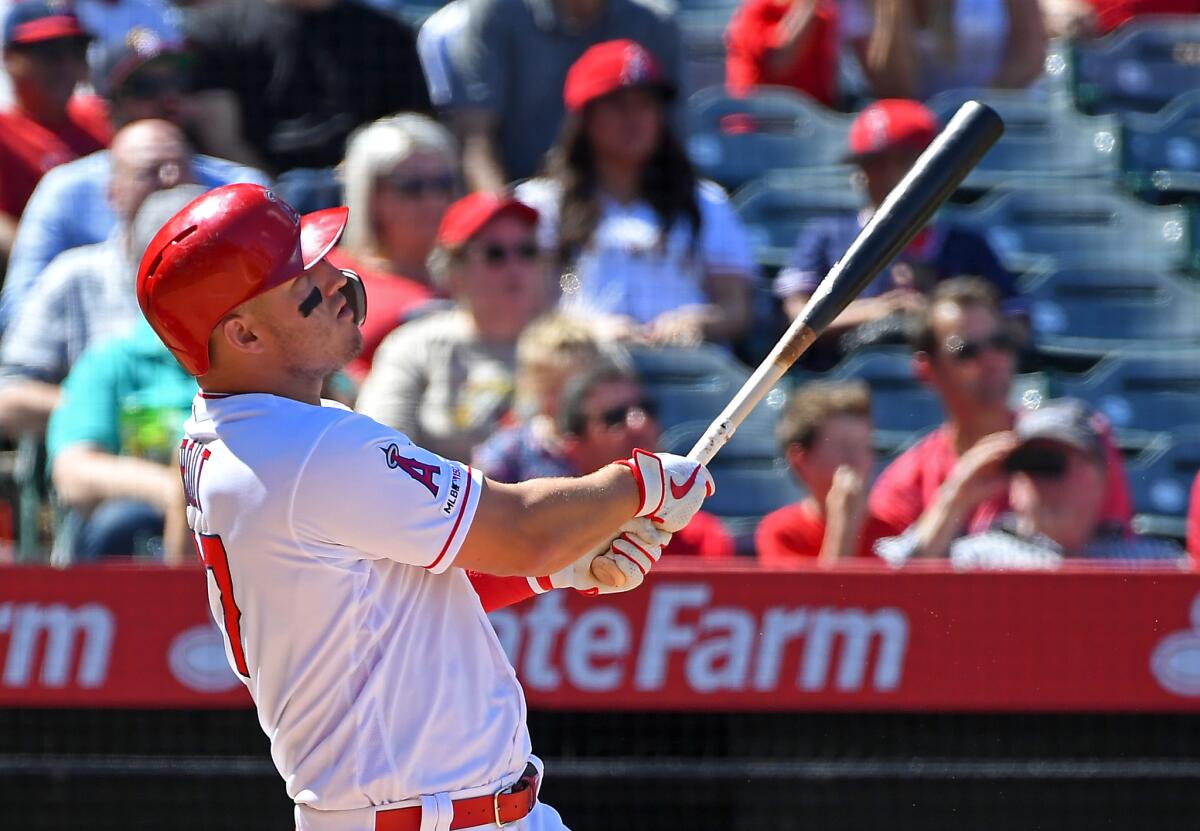
Wonder what it would be like to step into the batter’s box with Mike Trout and face Justin Verlander? Or to catch Shohei Ohtani’s split-fingered fastball? Or to range behind second base for a grounder and spin 360 degrees before firing to first base like Andrelton Simmons?
Fox spiced up last summer’s All-Star broadcast by capturing live exchanges between players who were mic’d up during the game, and with fans relegated to watching on television, networks should continue to mic up players this summer.
But in a shortened season of experimentation, why not take it to the next level? MLB should mount an action camera on top of the catcher’s face mask and cap of a position player for one inning and batting helmet of a hitter for at least one at-bat per game.
That would bring fans closer to the action, creating a virtual-reality-like experience for those at home, and if there’s a heated exchange between pitcher and batter after a chin-high fastball, so be it. It’s probably nothing worse than a kid would hear in a social-media video of a customer getting berated for refusing to wear a face covering in a grocery store.
— Mike DiGiovanna
You make the call
The most unappreciated, scorned people at a ballgame are the men in black. Take the mini-cam idea one step further and outfit plate umpires with them so fans can call pitches in real time with a view from behind the catcher.
Try to determine whether that 92-mph slider caught the outside corner at the knees or just missed. Not via replay. Not in slow motion. Now.
On the day the Angels began training camp, superstar Mike Trout said he might not play because his wife is pregnant and he’s worried about COVID-19.
The umpire’s call would stand, but an app that would enable fans to call either ball or strike in the first two seconds after a pitch hits the catcher’s mitt would be cool. No doubt the team fans root for would benefit from their calls. The real umpires have no such bias.
Play at the plate? Fans safe at home would determine whether the runner was safe at home. Not via replay. Not in slow motion. Now. The same could be done with base umpires. The result could be fans developing a healthy respect for a difficult job — until an umpire blows a call, of course.
— Steve Henson
Designate a trash-talker
When baseball returns, it will do so at the same ballparks we remember before the pandemic but they will look and sound different. The cheering and booing we’ve grown accustomed to will be replaced by an eerie silence. MLB teams should have the ability to pick one fan to sit behind home plate to give them some semblance of a home-field advantage.
This fan would wear a mask and be the only person in the section. He or she would not be a health concern, but should be a concern for visiting teams if home teams choose the fan wisely. This would essentially be an all-star heckler, who would try to distract visiting teams during the game. The fan could change every game or the same one could be used all season. No cursing or personal comments allowed, but otherwise the fan can do whatever possible to give the home team an edge.
— Arash Markazi
Make ‘roids all the rage
Temporarily stop drug testing. Why not?
It’s not as if this season will have any credibility. Sixty games isn’t a season, it’s a glorified exhibition schedule. Ask any Japanese player about the greatest challenge he encountered when moving to the major leagues. He will say it’s the relentless schedule. The major leagues are the major leagues because of the 162-game grind.
Which isn’t to say this season can’t or won’t be fun. The World Baseball Classic format isn’t conducive to determining the best team, but it is entertaining. In abbreviated competitions, anything can happen.
The Dodgers were scheduled to host the All-Star game July 14, but it was canceled and the 2020 season delayed to July 23 because of the coronavirus.
Baseball might as well embrace the chaos. If the point of this short season — other than to provide broadcast partners with desperately-needed content — is to see what kind of madness will unfold, the sport might as well push that idea to the extreme.
Triple-digit radar gun readings have become routine. How hard could someone throw if there was no danger a urine sample might be demanded after the game? How far could someone launch a ball?
Let’s be honest: The most entertaining stretch for the Dodgers since their 1988 World Series championship was the two months after they traded for Manny Ramirez. Remember Mannywood? Let’s see it again. Let some other gassed-up player charm the city.
— Dylan Hernandez
Cut it out
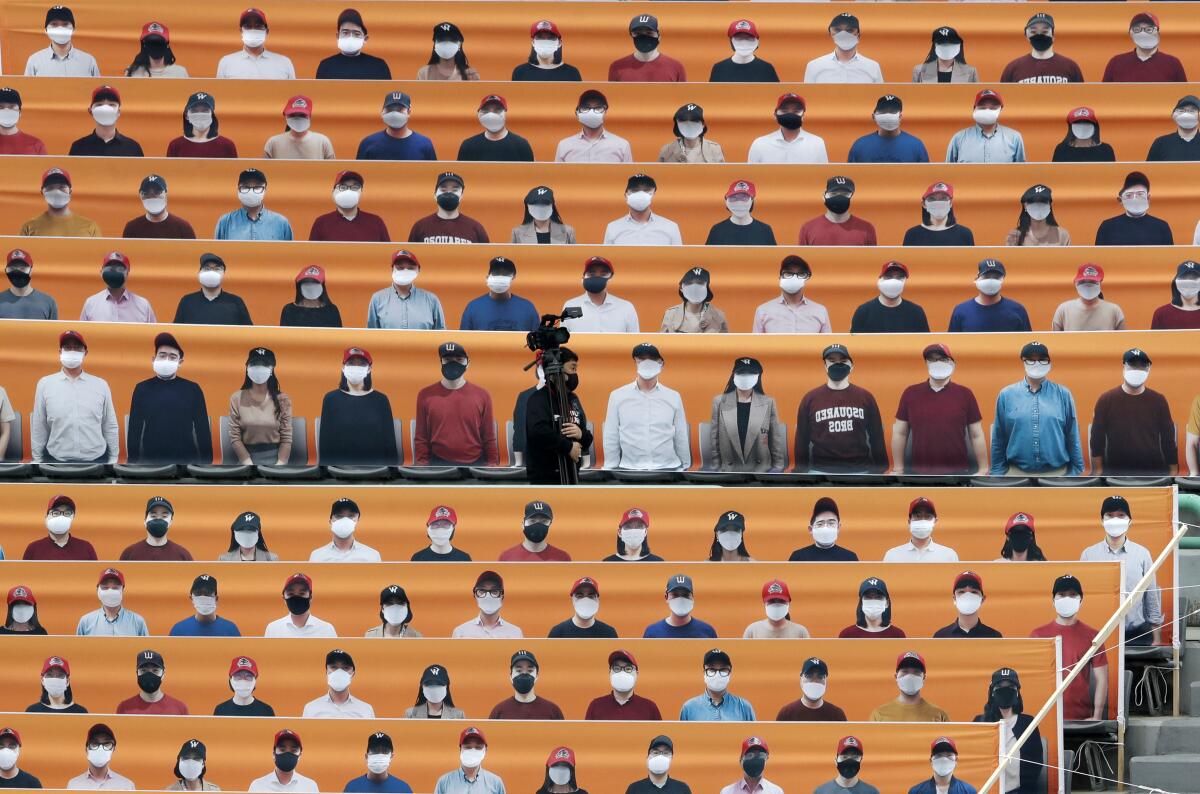
Without fans, those stadiums are going to look empty. Why not fill seats with cardboard cutouts topped by the faces of fans? A donation to a charity could be the requirement for fans to get their image and cardboard replica in the ballpark. The A’s and Giants announced plans to fill their seats with cardboard cutouts, but the Angels and Dodgers can apply their own unique spin: Let fans choose if they want their image to wear an Angels cap or to be eating a Dodger dog, for instance.
Teams also could create cutouts with the images of former stars or of past championship teams and then feature those players or teams during their broadcasts. For an extra donation to charity, fans could ask to have their cardboard image sit next to their favorite former players’ images. No social distancing required among cutouts.
Also, why not put a Gene Autry cutout in the stands in Anaheim or a Tommy Lasorda cutout in the box seats at Dodger Stadium, as a springboard to a history lesson during a telecast? Probably best to skip a Frank McCourt cutout, though. That memory is still too painful.
— Helene Elliott
More to Read
Go beyond the scoreboard
Get the latest on L.A.'s teams in the daily Sports Report newsletter.
You may occasionally receive promotional content from the Los Angeles Times.

